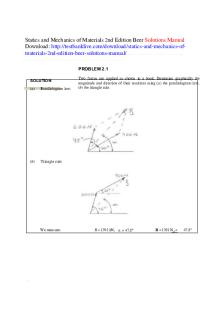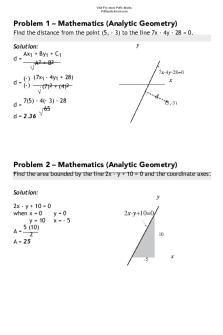Solutions Manual Classical Mechanics with Problems and Solutions 1st edition by David Morin PDF

| Title | Solutions Manual Classical Mechanics with Problems and Solutions 1st edition by David Morin |
|---|---|
| Author | Micheal Sullivan |
| Pages | 5 |
| File Size | 305.2 KB |
| File Type | |
| Total Downloads | 52 |
| Total Views | 161 |
Summary
Full file at https://buklibry.com/download/solutions-manual-classical-mechanics-with-problems-and-solutions-1st-edition-by-david-morin/ SOLUTIONS MANUAL Introduction to Classical Mechanics With Problems and Solutions David Morin Cambridge University Press Download full file from buklibry.com Full fi...
Description
Accelerat ing t he world's research.
Solutions Manual Classical Mechanics with Problems and Solutions 1st edition by David Morin Micheal Sullivan
Related papers
Download a PDF Pack of t he best relat ed papers
Int roduct ion t o Classical Mechanics Wit h Problems and Solut ions Yo Kyms
T HERE ONCE WAS A CLASSICAL T HEORY… Int roduct ory Classical Mechanics, wit h Problems and Solut … Byon Nugraha Jayawiguna int roduct ion t o classical mechanics Aya Anisa Dwinidasari
Full file at https://buklibry.com/download/solutions-manual-classical-mechanics-with-problems-and-solutions-1st-edition-by-david-morin/
SOLUTIONS MANUAL
Introduction to Classical Mechanics With Problems and Solutions
David Morin
Cambridge University Press
Download full file from buklibry.com
Full file at https://buklibry.com/download/solutions-manual-classical-mechanics-with-problems-and-solutions-1st-edition-by-david-morin/
TO THE INSTRUCTOR: I have tried to pay as much attention to detail in these exercise solutions as I did in the problem solutions in the text. But despite working through each solution numerous times during the various stages of completion, there are bound to be errors. So please let me know if anything looks amiss. Also, to keep this pdf file from escaping to the web, PLEASE don’t distribute it to anyone, with the exception of your teaching assistants. And please make sure they also agree to this. Once this file gets free, there’s no going back. In addition to any comments you have on these solutions, I welcome any comments on the book in general. I hope you’re enjoying using it!
David Morin [email protected]
(Version 2, April 2008)
c David Morin 2008 °
Download full file from buklibry.com
Full file at https://buklibry.com/download/solutions-manual-classical-mechanics-with-problems-and-solutions-1st-edition-by-david-morin/
48
CHAPTER 5. CONSERVATION OF ENERGY AND MOMENTUM (b) This only difference is that now the integral starts at L/2 instead of zero. So we have F = 2πσGm sin θ cos θ
Z
L
L/2
dx = 2πσGm sin θ cos θ (ln 2). x
(176)
Since sin θ cos θ = (1/2) sin 2θ, this force is maximized when 2θ = 90◦ =⇒ θ = 45◦ . 5.58. Sphere and cones (a) There is no change in speed inside the shell. The potential energy at the surface of the shell is V (R) = −
Gm(4πR2 σ) GmM =− = −4πGmRσ. R R
Conservation of energy then gives 0 = mv 2 /2 − 4πGmRσ =⇒ v =
(177) √
8πGRσ.
(b) Let’s find the potential energy at the tip of the cones, due to one of the cones. We’ll slice the cone into rings and then integrate. Consider a thin ring around the cone, located at a slant distance x away from the tip. The radius r of the ring is given by r/x = R/L =⇒ r = xR/L. So
¡
¢
Gm 2π(xR/L) dx σ Gm dM =− = −2πGm(R/L)σ dx. dV = − x x
(178)
Integrating from x = 0 to x = L simply gives V = −2πGmRσ. We need to double this because there are two cones, so we end up with the same potential of −4πGmRσ as in part (a), which means that we obtain the same speed of √ v = 8πGRσ, independent of L. 5.59. Ratio of potentials In the first picture, the big square can be built up from four of the small ones (with the mass at the corner of each), so A = 4. In the second picture, consider a tiny patch of area in the small square. This patch gives some contribution to the potential energy of m. Now consider the corresponding patch in the big square. What is the contribution of this patch to the potential energy of m? Well, the larger patch has four times the area (and hence mass) as the smaller patch, because areas are proportional to lengths squared. But it is also twice as far from m, compared with how far the smaller patch is from m in the small square. So if the smaller patch contributes Gm(dM )/r to the potential in the smaller square, then the larger patch contributes Gm(4dM )/2r to the potential in the larger square. This is twice as much, and this relation holds for all corresponding patches, so B = 2. Putting the two pictures together then tells us that a mass at the center of a given square has twice the (negative) potential that a mass at a corner of the same square has. 5.60. Solar escape velocity Let v0 ≈ 30 km/s be the orbital speed of the earth. Let the desired speed p with respect to the earth be v. The escape velocity from just the earth is ve = 2GMe /Re ≈ 11.2 km/s. The escape velocity from the sun, starting at the location p of the earth’s 2GMs /Res ≈ orbit (but excluding the orbital motion of the earth), is vs = 42 km/s, where Res is the earth-sun distance. After the object has escaped the earth’s gravitational field, conservation of energy p √ v 2 − 2GMe /Re = v 2 − ve2 . The gives the speed with respect to the earth as speed with respect to the sun at this point is then (assuming√that the object is wisely fired along the direction of the earth’s orbital motion) v 2 − ve2 + v0 . By
Download full file from buklibry.com
Full file at https://buklibry.com/download/solutions-manual-classical-mechanics-with-problems-and-solutions-1st-edition-by-david-morin/
98
ˆ CHAPTER 8. ANGULAR MOMENTUM, PART I (CONSTANT L)
8.59. No final rotation Let vb and vs be the final velocities of the ball and stick, with rightward and leftward taken to be positive, respectively. Conservation of p, E, and L (around a dot on the table where the initial center of the stick is) give 0 2
1 mℓ ω02 2 12 ³ 2´ mℓ ω0 12
³
´
=
M vb − mvs , ´ 1 1 0 + mvs2 + M vb2 , 2 2 ℓ (0 + 0) + M vb . 2
³
= =
(455)
(We have noted that in general the stick’s contributions come from both the motion of the CM and the motion relative to the CM.) Using the first and third equations to write vb and vs in terms of ω0 , the second equation gives M = m/2. 8.60. Same final speeds Let v be the common final speed. Let ω be the final angular speed of the stick. Then conservation of p, E, and L (around a dot on the table where the center of the stick is when the collision occurs) give mv0 1 mv02 2 0
= = =
2mv, ³ ´ 1 1 1 (Amℓ2 )ω 2 + mv 2 + mv 2 , 2 2 2 ℓ −(Amℓ2 )ω + mv . 2
(456)
The first equation gives v = v0 /2, and then the third equation gives ω = v/2Aℓ = v0 /4Aℓ. Plugging these into the second equation yields A = 1/8. 8.61. Perpendicular deflection Let vx and vy be the final velocity components of the center of the dumbbell, with rightward and downward positive, respectively. The moment of inertia of the dumbbell around its center is 2m(ℓ/2)2 = mℓ2 /2. Conservation of px , py , E, and L (around a dot on the table where the initial center of the stick is) give M V0
=
0
=
1 M V02 2
=
ℓ 2
=
M V0
M V0 , 2m Mu , M u − (2m)vy =⇒ vy = 2m µ ³ ´ ¶ 1 1 mℓ2 1 ω2 , M u2 + (2m)(vx2 + vy2 ) + 2 2 2 2
0 + (2m)vx
³
mℓ2 ω 2
´
=⇒ vx =
=⇒ ω =
M V0 . mℓ
(457)
Plugging the vx , vy , and ω from the first, second, and fourth equations into the third gives u = V0
r
2m − 2M . 2m + M
(458)
So we need m ≥ M for this setup to be possible (although the case of equality leads to M being at rest). 8.62. Glancing off a stick Since there is no force in the y direction √on the mass (because the stick is frictionless), the y speed of the mass remains v0 / 2, and the CM of the stick ends up moving only in the x direction. Let v be the resulting speed of the CM, and let ω be the
Download full file from buklibry.com...
Similar Free PDFs

Example problems and solutions
- 142 Pages
Popular Institutions
- Tinajero National High School - Annex
- Politeknik Caltex Riau
- Yokohama City University
- SGT University
- University of Al-Qadisiyah
- Divine Word College of Vigan
- Techniek College Rotterdam
- Universidade de Santiago
- Universiti Teknologi MARA Cawangan Johor Kampus Pasir Gudang
- Poltekkes Kemenkes Yogyakarta
- Baguio City National High School
- Colegio san marcos
- preparatoria uno
- Centro de Bachillerato Tecnológico Industrial y de Servicios No. 107
- Dalian Maritime University
- Quang Trung Secondary School
- Colegio Tecnológico en Informática
- Corporación Regional de Educación Superior
- Grupo CEDVA
- Dar Al Uloom University
- Centro de Estudios Preuniversitarios de la Universidad Nacional de Ingeniería
- 上智大学
- Aakash International School, Nuna Majara
- San Felipe Neri Catholic School
- Kang Chiao International School - New Taipei City
- Misamis Occidental National High School
- Institución Educativa Escuela Normal Juan Ladrilleros
- Kolehiyo ng Pantukan
- Batanes State College
- Instituto Continental
- Sekolah Menengah Kejuruan Kesehatan Kaltara (Tarakan)
- Colegio de La Inmaculada Concepcion - Cebu














